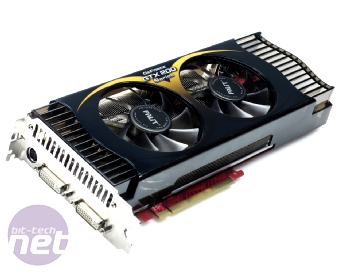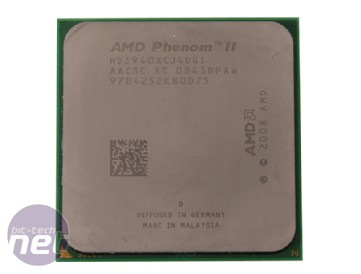What Hardware Should I Buy? - May 2009
May 6, 2009 | 11:45

Gaming Workhorse
While our enthusiast system is built around a dual core system, those looking to maximise gaming performance or do a ton of multi-tasking will want to pick up a quad-core CPU, which is what we’ve built our gaming workhorse system around.This system also offers much better stock performance than our enthusiast system, but of course this increase in performance and functionality out of the box means a noticeably higher price tag. While there’s still plenty of overclocking headroom here if you’re not too confident when it comes to overclocking we’d point you in this direction.
In addition to the nippy quad core and high end cooling we’ve again included a high end GPU, although deciding between Nvidia’s GTX 275 and ATI’s HD 4890 1GB is difficult, as both provide very similar graphics headroom at a very similar price. Whichever you choose will deliver fantastic gaming performance.

Graphics Card

First Choice: Palit GeForce GTX 275
UK Pricing: £199.98 (inc. VAT)
US First Choice: EVGA GeForce GTX 275 Superclocked
US Pricing: $252.00 (ex. Tax)
We've been very impressed with the GeForce GTX 275, which just managed to squeeze into last months guide, thanks to it offering graphics performance within ten percent of the higher end GeForce GTX 285 for a comfortable £100 less, a huge saving which has made the GTX 275 a real favourite here at bit-tech.
However, we were pleasantly surprised to find that Palit's version of the card, using a custom PCB, cooler and power delivery system, was even better. While similar cooler designs have disappointed in the past the Palit GeForce GTX 275 was able to keep the GPU cooler at both idle and load than a stock GTX 275, while also consuming noticeably less power, and all this despite costing a good £15 less than a standard, Nvidia built, GeForce GTX 275.
As the Palit GeForce GTX 275 ships at the reference speeds, graphics performance was also identical to a standard GTX 275, making the Palit an easy choice - it's cooler, quieter and cheaper than a stock GTX 275 in every way, while delivering identical graphical performance.
However, there is one let down (other than the fact the card isn't available in the USA - sorry!) in the form of the Palit's overclocking potential, which has proven to be much less than our Nvidia designed GTX 275 review samples. While perfectly stable at stock speeds overclocking the Palit's memory even a fraction led to severe instabilities and we also found the core and shader clocks frustratingly unresponsive. It's clear then that while the Palit GTX 275 is the ideal choice if you're happy with stock speeds, overclockers should most definitely look elsewhere.
Stateside, we realise the Radeon HD 4890 has a more aggressive and tempting price, so our friends to the West might be tempted down the red route - and that certainly wouldn't be a bad purchase - it's just that the GTX 275 is generally faster in more of our benchmarks and when it's slower than the 4890, it's not by as bigger margin.
Even when it comes to unique feature sets there's not a lot to separate the cards though. While the GTX 275 comes with support for Nvidia's PhysX and CUDA technologies, along with much better folding performance, the motherboard we recommend below only supports CrossFire and not SLI, so the ATI card offers a multi-GPU upgrade path in the future. There are obvious pros and cons to each, so you'll have to decide if PhysX, CUDA, and better folding performance or multi-GPU is more important to you in the short term.
Whichever you opt for, paired with the quad core processor we've selected below you'll end up with a fantastically capable multi-threaded gaming system that should last a good 18 months to two years before requiring a significant upgrade.
CPU
First Choice: AMD Phenom II X4 940 Black Edition
UK Pricing: £155.47 (inc. VAT)
US Pricing: $189.99 (ex. Tax)
Intel’s seminal Core 2 Quad Q6600 quad core processor has almost had its day. It's been a fantastic run for the budget quad core that kept a fantastic price, but stocks seem to be getting thin in the UK and from what's left we've seen a price hike to over £150. With that in mind, we priced up several systems this month and had a big head scratching session as what to recommend.
The Intel Core 2 Quad Q6600 G0 stepping, with excellent Maximus II Formula and 4GB of 1,066MHz DDR2 equates to about £360, while the AMD Phenom II X3 720 Black Edition, with MSI 790FX-GD70 and 4GB of 1,333MHz DDR3 is only £320. This is a £40 saving, but also at a loss of a core and including more expensive, but negligibly beneficial DDR3.
Swap the CPU for a Phenom II X4 955 and that now becomes about £400 - more than our original, but not that much more to show for it. It'll clock higher than the Q6600, but the Intel core is more efficient so there's an arguable overlap. The Phenom II X4 940, with Asus M3A79-T Deluxe and 4GB of 1,066MHz DDR2 seems like the best mix in our minds - with a bundle price of around £330 - £30 cheaper than the Q6600, but with a higher core clock and solid overclock it's the right combination.
The only problem is upgradeability - socket AM3 CPUs will fit in socket AM2+ boards, but we can't take advantage of the excellent MSI 790FX-GD70 since AM2+ CPUs won't fit in AM3 sockets. That's a conundrum we'll have to work our way through over the next few weeks!
Motherboard
First Choice: Asus M3A79-T DeluxeUK Pricing: £136.84 (inc. VAT)
US Pricing: $189.95 (ex. Tax)
This is one of those boards we wish we'd reviewed. Or, to put it more precisely, hadn't killed after several months of significant abuse on our test benches - if you know how much hardware we go through, it's more indicative of the usage scenario than Asus build quality. We got fairly intimate with the M3A79-T Deluxe late last year and used it exclusively for our AMD CPU testing for a few months. It turned out to be a great board - a fantastic BIOS that was easily overclockable, and rounded off with an overall great layout, cool running and solid set of hardware.
The M3A79-T Deluxe is end of life though and has been replaced with the M4A79, however we'd still opt for the original while you can find it because it's cheap and a known factor by us in the labs. Coupled with a Phenom II X4 940, 3.6 to 3.8GHz should certainly be attainable with the right CPU cooler, and the M3A79-T has enough PCI-Express slots for extra graphics hardware or other peripherals.
We did try to include the MSI 790FX-GD70 in this month's guide, but DDR3 is just that much more expensive and there's no Black Edition AM3 quad core comparative for ~£150. Yet.

MSI MPG Velox 100R Chassis Review
October 14 2021 | 15:04








Want to comment? Please log in.